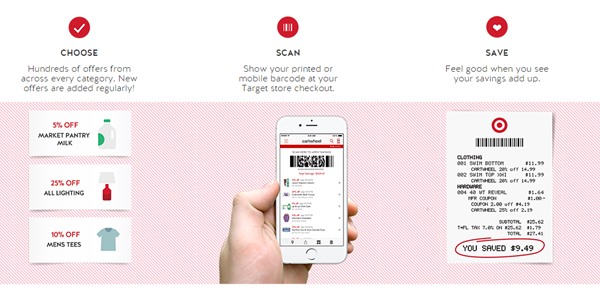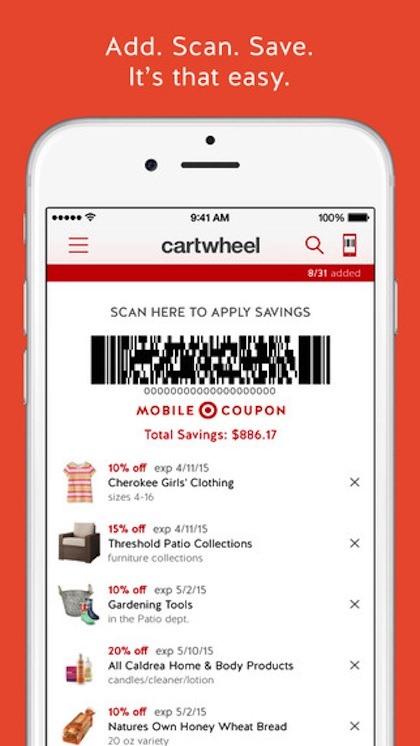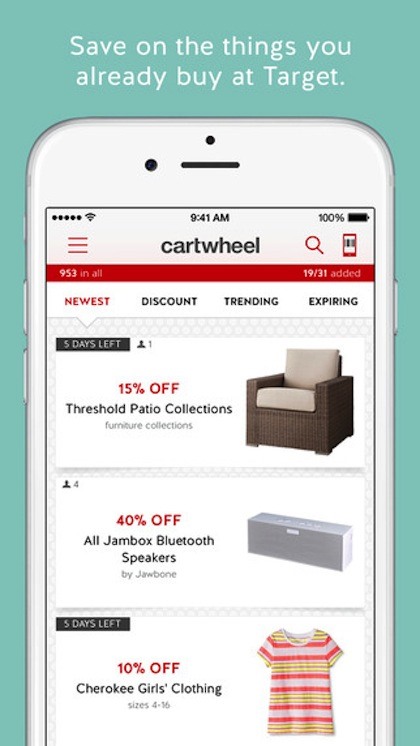Target’s Omnichannel Two-App Tactic

If there’s one thing that can be said for sure, it’s that you don’t get to be the second largest discount retailer in the United States without having a strategy for how to get there. And it has to be said, as strategies go, you don’t get much more (ahem) targeted than Target’s omnichannel two-app tactic.
The retail giant has been using mobile, not just as means to deliver discounts, but as a way to solve problems for its shoppers and create a more personalised experience that instils loyalty.
"Mobile is becoming increasingly important to all digital retailers, and given the profile of our guests [i.e. customers], it's particularly important for Target, as mobile accounted for more than 40 percent of our digital orders in the fourth quarter," said CEO Brian Cornell during a conference call with analysts in March last year. "And notably on Black Friday, 10 percent of our iPhone app revenue was from guests purchasing on their phone while they were simultaneously shopping one of our stores."
Impressive figures indeed – but how does Target do it?
From Strategy To Execution
When, in 2013, Maria Brinas-Dobrowski began her role as Technical Architect Consultant at Target, discussions immediately began about what would be the giant retailer’s next-generation mobile device for store workers and its next application architecture.
Speaking at New Relic’s FutureStack15 user conference, she told her audience that the digital transition would become part of Target’s DNA.
“The company plans to use mobile as part of its omnichannel strategy,” she said. “Target wants to deliver the same great experience whether ‘guests’ [customers] are in the store, on the web, or on a mobile device.
“The company is spending $1 billion to grow from the ‘analysis paralysis’ of being a superior planner and inferior doer, to being a superior planner and at the same time a superior doer.”
This superior “doing” manifested in Target’s two-app strategy, which, importantly, has been designed primarily to focus on customer convenience, whether in-store or online.
“Rather than inundating shoppers with marketing messages, Target is choosing to focus on apps and features that solve problems for shoppers, preferably before the shopper realizes there is a problem,” said Alan Wizemann, Target’s VP of Product.
The identified “problems” that Target’s apps solve involve helping in-store customers navigate their way around large stores with in-store maps, as well as organizational problems such as creating integrated shopping lists.
Cartwheel

Target spent a year developing the Cartwheel app to sit alongside the flagship Target app. Cartwheel allows users to build shopping lists that enable them to find everything within Target’s brick-and-mortar locations. The app plays into consumers’ interest in shopping for deals, and brings couponing into the digital age for a more comprehensive and convenient experience.
Target noticed that many shoppers were using Cartwheel as a method of keeping track of their future purchases, much like a shopping list. This prompted the retailer to introduce a feature to better assist in-store shoppers at checkout with an option to reorder digital coupons with a touch of a finger, enabling better organization and streamlined in-store shopping.

The new option is just a small change, but supports the overall effectiveness of the app, which is vital to the success and adoption of commerce apps. Users can add coupons from various printouts as well as congregated deals within the app, and keep them all organized within their mobile devices rather than traveling with an abundance of printed coupons.
Cartwheel Success
A recent report by comScore detailed how the app has leveraged consumer’s routine shopping and interest in deals, resulting in growth of 85% year over year. Originally, the app surpassed 7 million users and updated with enhanced social features when the shopping application celebrated its one-year anniversary.

Indeed, plans for the app are not static – evolution is anticipated excitedly by Target.
“Initially, the feature may not have a material affect on sales, since it will take some time to accumulate a critical mass of consumers that have both installed iOS9 and found the new feature in the app,” said Michael Becker, co-founder and managing partner, mCordis, Sunnyvale, CA. “Over time, however, executed effectively, the press and drag user experience can reduce the steps to prioritizing and accomplishing a task, but more importantly it may help the app design team enhance the experience even further.
“For example, if Target implements a beacon network, this capability may enable an auto-reording of offers on the Cartwheel visual map (a really cool feature in my opinion) as the shopper navigates the store. All of this may lead to a reduction in friction, reduction in steps (both virtually and physically).
“A reduction in friction, as has been learned from online shopping cart conversation reports, leads to increased engagement, conversation and ultimately revenue.”
BOPUS
But perhaps the most remarkable hit with shoppers has been Target’s BOPUS (buy online pickup in-store) programme. During Black Friday Week in 2014, customers made more than 400,000 in-store pickups.
“We spent tens of millions of dollars reinventing our store assets into flexible distribution models where guests have full control over whether they buy online or pick up in-store,” said Target President Jason Goldberger, speaking at the Internet Retailer Conference and Exhibition in Chicago last year.
It’s appeared to pay off – 25% of digital orders are picked up in-store, edging closer to 50% during peak holiday seasons.
Curbside Pickup
Target has also been trialling curbside pickup at a handful of stores in California, where customers don’t even need to leave their cars when picking up goods they’ve purchased online – Target employees bring the products out to them.
Here’s how it works: Customers download the free Curbside app, select a Target store, choose their products (items on offer match up with the store’s inventory, so the app only displays products that are available), pay for them, and then make their way to the store.
A Target employee will gather the items, and send a mobile alert to the customer when the purchase is ready. The app itself is smart enough to then alert the employee when the customer is nearby, so that everything is ready to be loaded into the car (usually from a tent that’s set up in front of the store) upon arrival.
Flexible Customer Models
In addition, Target has also been testing other flexible customer models, including ship-from-store, free shipping for all online orders, and a Target Subscriptions business for repeat household purchases.
“Yes, there was a real cost per order [with free shipping] and we had to eat that cost, but we found our digital sales soared because guests realized the value we were giving them,” said President Jason Goldberger in Ad Exchanger. “The economics of losing a guest to our competitor is no longer a consideration.”
The Results
Target’s strategy has paid off. In February the sales figures for Q4 2015 were announced, revealing a 34% increase in digital sales in this quarter, well ahead of Walmart at only 8%, and more than twice that even of Amazon (15%).
The combination of omnichannel innovations and free shipping proved to be the winning blow – Walmart opted to keep its $50 free shipping threshold, and evidently paid the price in terms of growth. Target now ships from 460 of its 1,792 US stores.
For the whole year, Target’s digital sales were up 31%, with omnichannel telling a significant part of the story. 30% of Q4’s digital sales came from either ship-from-store or BOPUS transactions. Indeed, the latter has worked so well for Target that customers guests even take to utilising BOPUS whilst they’re in-store.
Target chairman and CEO Brian Cornell in the Multichannel Merchant:
“We recognize that today, our Target guest interfaces with the brand in a number of different ways. Sometimes they’re in our store. Sometimes they’re shopping online. […] So we felt really good about the way the guests responded to our offers during the fourth quarter, and a great combination of in-store traffic and more guests than ever before, clicking and collecting items in our store.”
![]()
About John Waldron: John Waldron is a technology and business writer for markITwrite digital content agency, based in Cornwall, UK. He writes regularly across all aspects of marketing and tech, including SEO, social media, FinTech, IoT, apps and software development.